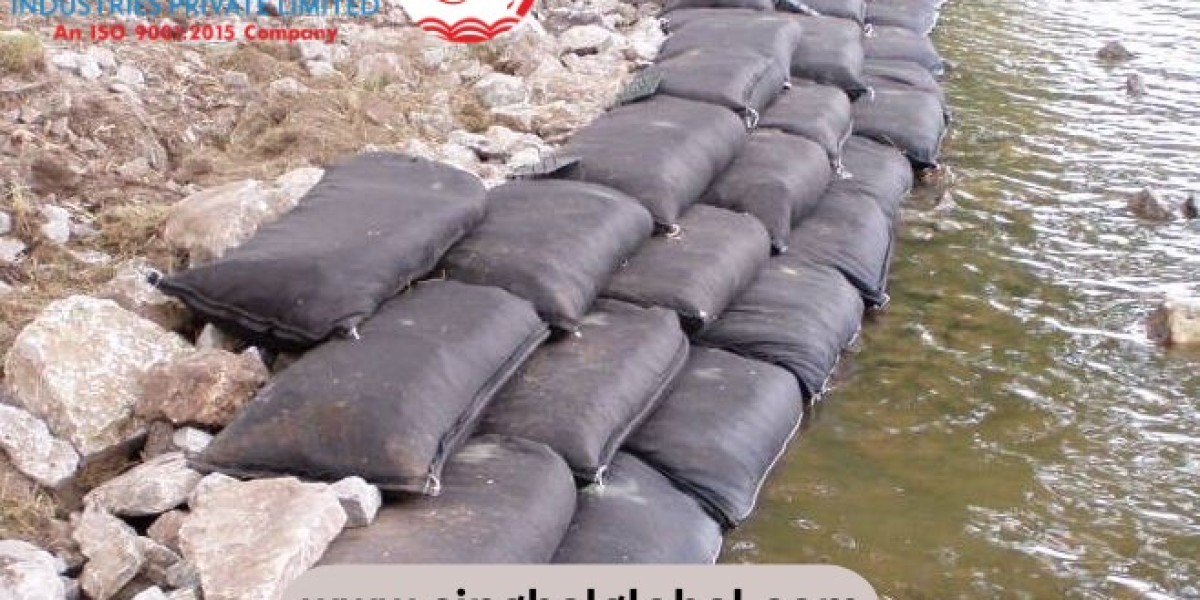Waterways play a critical role in the environment, economy, and infrastructure of a nation. However, natural and man-made factors like erosion, sedimentation, and flooding pose significant challenges. One of the most innovative and cost-effective solutions to these challenges is the use of geotextile bags, also known as geo bags. These specially designed bags provide effective sediment control, shoreline protection, and reinforcement of embankments.
In recent years, the demand for geo bags has increased significantly, particularly in countries like India, where rapid urbanization and industrial growth necessitate robust environmental protection measures. Various Geo bags industries in India are investing in research and development to create durable, sustainable, and high-performing geotextile bags.
What Are Geotextile Bags?
Geotextile bags are specially fabricated containers made from permeable and durable geotextile fabric. These bags are typically filled with sand, soil, or other natural materials and used for various environmental and engineering applications. They help in:
- Erosion control along riverbanks, coastal areas, and embankments.
- Sediment management in water bodies to prevent excessive accumulation.
- Shoreline stabilization against waves, tides, and heavy rainfall.
- Flood protection by reinforcing weak areas of riverbanks and coasts.
The efficiency of geo bags comes from their ability to allow water to pass through while retaining the solid contents inside. This permeability ensures that excess water drains out without causing soil loss, making these bags ideal for long-term sediment control.
Applications of Geotextile Bags in Waterways
Geotextile bags are extensively used across different sectors for environmental protection and infrastructure development. Some key applications include:
1. Riverbank Protection
Rivers are dynamic ecosystems that experience continuous erosion due to water flow, seasonal changes, and human activities. Geotextile bags offer a strong yet flexible solution for stabilizing riverbanks. When placed strategically, these bags prevent soil erosion and maintain the natural contour of the river.
2. Coastal Protection
Coastal areas are vulnerable to erosion due to tidal action, storms, and climate change effects. Geo bags act as an effective barrier against waves, reducing the impact of water forces and protecting coastal infrastructure. They are widely used for constructing artificial dunes, breakwaters, and revetments.
3. Flood Prevention and Control
Floods can cause immense damage to property, agriculture, and human lives. Geotextile bags, when used as flood barriers, help in diverting and containing floodwaters. Their lightweight nature makes them easy to transport and deploy during emergencies.
4. Dredging and Sediment Control
Sediment accumulation in water bodies can reduce their depth and impact aquatic ecosystems. Geotextile bags are used to store dredged sediments and gradually release water, preventing contamination and helping in sustainable sediment management.
5. Infrastructure Reinforcement
Geotextile bags are also used in road and railway embankments, bridges, and canal reinforcements. They improve the stability of soil structures, making them resistant to weather and load-bearing challenges.
Benefits of Using Geotextile Bags
1. Cost-Effective Solution
Compared to conventional sediment control methods like concrete walls or rock embankments, geo bags offer a more affordable alternative. The materials are readily available, and installation is quick and efficient.
2. Environmentally Friendly
Geo bags blend naturally with the environment, allowing vegetation to grow over time. This eco-friendly approach minimizes disruption to the ecosystem while ensuring long-term protection.
3. High Durability and Strength
Made from high-quality geotextile fabric, these bags are designed to withstand harsh environmental conditions, UV exposure, and constant water movement. Leading Geo bag manufacturers in India produce high-strength bags that last for years.
4. Easy Installation and Maintenance
Unlike traditional sediment control structures, geotextile bags require minimal labor and equipment for installation. Once placed, they require little to no maintenance, making them an efficient choice for long-term use.
5. Customization and Versatility
Geotextile bags come in different sizes, shapes, and fabric types, depending on their application. This versatility makes them suitable for a wide range of projects, from small-scale land stabilization to large-scale coastal protection initiatives.
Industries of Geo Bag in India: Leading the Way
India is one of the fastest-growing markets for geotextile bags, with numerous companies specializing in their production, export, and innovation. The geo bag industries in India are investing in sustainable materials and advanced manufacturing techniques to cater to both domestic and international markets.
Several geo bag manufacturers in India focus on high-quality, UV-resistant, and durable products that meet international standards. These manufacturers work closely with environmental agencies, government projects, and construction companies to ensure effective sediment control solutions.
Additionally, geo bag exporters in Ahmedabad are playing a crucial role in supplying these products to global markets. Ahmedabad, known as an industrial hub, hosts several leading companies that export geotextile bags to various countries in Asia, Africa, and the Middle East.
Future of Geotextile Bags in Waterway Management
As climate change continues to impact coastal regions and riverbanks, the need for effective sediment control solutions is growing. Geotextile bags will continue to evolve with improved materials and technology.
Future trends in the industry include:
- Use of biodegradable geo bags for temporary sediment control solutions.
- Integration of smart textiles that can monitor erosion and environmental conditions.
- Expansion of export markets, with geo bag exporters in Ahmedabad leading global supply chains.
With government initiatives promoting eco-friendly infrastructure and sustainable development, the demand for geo bags is expected to rise, making them a crucial component in waterway management.
Conclusion
Geotextile bags have emerged as a smart sediment control solution, offering cost-effective, environmentally friendly, and durable protection for waterways. With increasing awareness and investment in sustainable infrastructure, the role of geo bag industries in India continues to grow.
From geo bag manufacturers in India producing high-quality products to Geo bag exporters in Ahmedabad expanding global reach, the industry is poised for further advancements. As the demand for efficient erosion control and flood management solutions increases, geotextile bags will remain a preferred choice for waterway protection worldwide.
Frequently Asked Questions (FAQs)
- How long do geotextile bags last in water?
Geotextile bags are designed to be highly durable and can last anywhere from 5 to 20 years, depending on factors like material quality, UV exposure, and environmental conditions. High-grade UV-resistant bags from reputed geo bag manufacturers in India offer extended longevity.
2. Can geotextile bags be reused after deployment?
In most cases, geotextile bags are designed for single-use applications, especially when filled with sediments. However, in controlled conditions, some geo bags may be emptied, cleaned, and reused.
3. Are geotextile bags suitable for all types of soil?
Yes, geotextile bags can be used with various soil types, including sandy, clayey, and silty soils. The permeability of the fabric ensures efficient drainage and sediment retention, making them adaptable to different environments.


